In this Met Parachute MCR review, we will look into what makes this such a well-liked helmet, what the downfalls are, and if it’s the right helmet for you.
The MET Parachute MCR is a high-end, convertible lid made for mountain bikers who tackle serious trails. The Parachute MCR is protective, comfortable, breathable, and most importantly- looks good.
MCR stands for Magnetic Chinbar Release which is one of the standout features on the helmet. While most convertible helmets to date use a mechanical latch type of attachment, the MCR has gone for a magnetic attachment. This allows for quick and easy detachment and reattachment of the chin bar.
Convertible helmets have taken off in the past few years and for good reason. For the same price as a full-face helmet, you can get a detachable lid which then gives you the option of using a half-shell too! We have been riding with detachable helmets for a few years now, and won’t be going back any time soon.
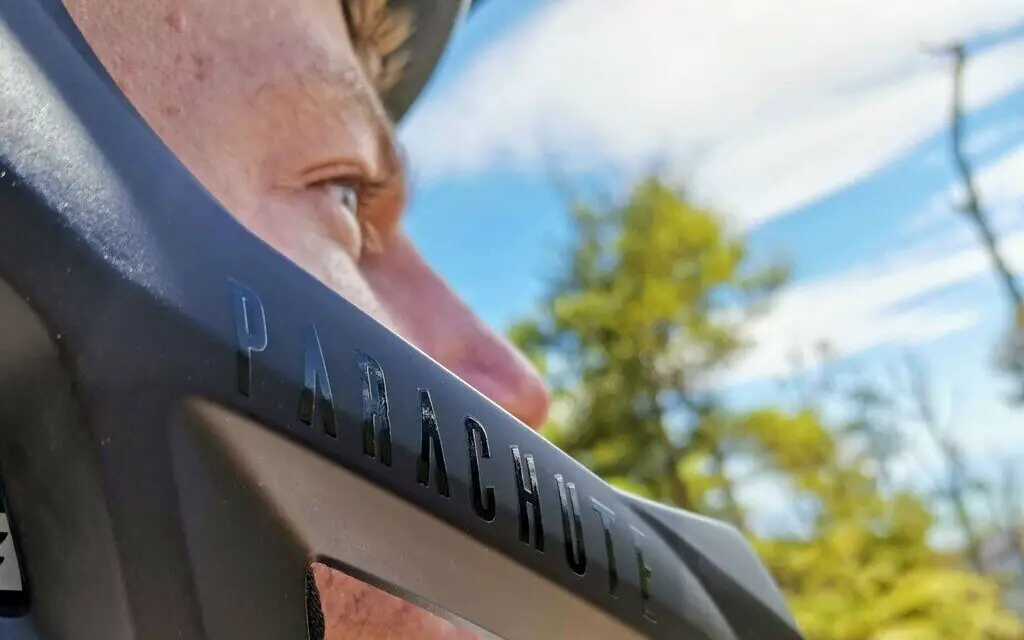
What Makes a Convertible Lid Good?
There are a few things you need to keep an eye out for with convertible lids.
Safety Rating
There are a number of safety certifications a helmet can have. To be able to be sold in many countries, helmets will have to meet a minimum standard, such as CPSC etc, depending on which country you are in.
There are also additional safety certifications, such as the downhill certification (ASTM F1952). The certification basically means the helmet can withstand a greater amount of force than helmets without the certification (more info can be found here).
If the helmet meets this certification, theoretically, you will be better off in a crash. However, in order to meet this, the helmet is generally a bit heavier and bulkier. So it is a trade-off between safety performance and weight/ breathability.
Some convertible helmets such as the Bell Super DH, MET Parachute MCR and the Giro Switchblade MIPS have been designed with a bit more bulk and protection to meet this requirement. Other convertible helmets are designed to be a bit lighter, more breathable, and don’t meet this requirement- such as the Bell Super Air R or Bell Super 3R.
Comfort, Ventilation and Weight
After safety, the level of comfort, ventilation and weight are the biggest deciders in choosing a helmet. An uncomfortable, heavy and hot helmet is not one you are going to wear.
Look for a helmet that doesn’t squash your face, or have any pinch points around the head. Some helmets come with extra cheek pads in the box so you can pad out the chin bar as you need.
Ventilation in a full-face helmet can often be hard to achieve. This is where the convertible helmets really exceed. You can take off the chin bar for any climbs or sections where you want good ventilation. The helmets themselves are generally well ventilated too- with plenty of vents placed strategically to encourage airflow through the helmet.
A convertible helmet with the ASTM F 1952 rating tends to be heavier than a helmet without. This is because it will have a bit more bulk to it in order to meet the requirements of the certification. Having a little more weight is usually not too noticeable, unless you are racing or when you are switching between helmets. Generally, it won’t make much of a difference to your performance.
Met Parachute MCR Review
What’s good?
- Downhill Certified (ASTM F1952)
- MIPS
- Magnetic Chinbar Attachment system is easy and fast
- Flexible and adjustable visor
- Additional cheek padding included in the box
- Looks great with or without the chin bar
What’s not?
- Pricey (even relative to other convertibles)
- Visor sits quite high
Who is it for: Enduro riders in particular. But it really does suit a wide range of riders and abilities.
Chinbar Attachment System
Starting with the standout feature of the Parachute MCR, the Magnetic Chinbar Release. The magnets helmet it ‘snap’ into place, and then a twist of the dials secures it in place. To take it off, you give the dials a twist and a pull, and it will ‘pop’ out.
It is one of the easier and more secure latches we have come across on convertible helmets, and it becomes quite natural once you have done it a few times.
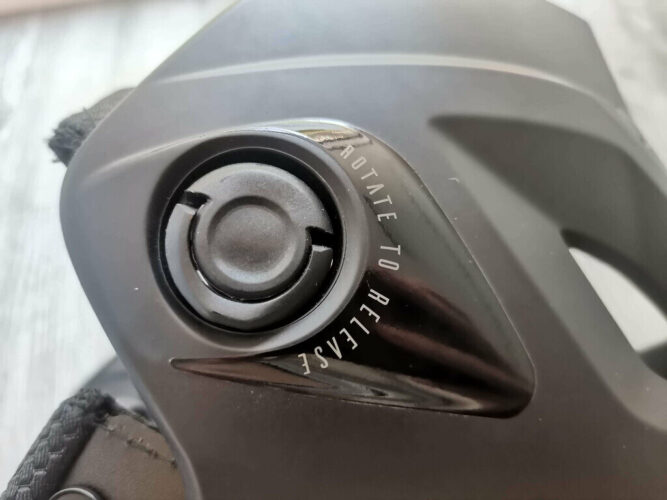
We tend to carry the chin bar around a loop in our shorts or waist pack while climbing, and clip it on once we need it.
Comfort and Fit
Simply put, the comfort and adjustability of the fit are outstanding. There are no pressure points around the head, the padding is soft and plush allowing for a great all around fit.
The BOA retention system (which is well known by road cyclists and snowboarders for tightening shoes and boots) is used to adjust the fit of the helmet. This system tightens around the head evenly and allows for fine-tuning using the dial.
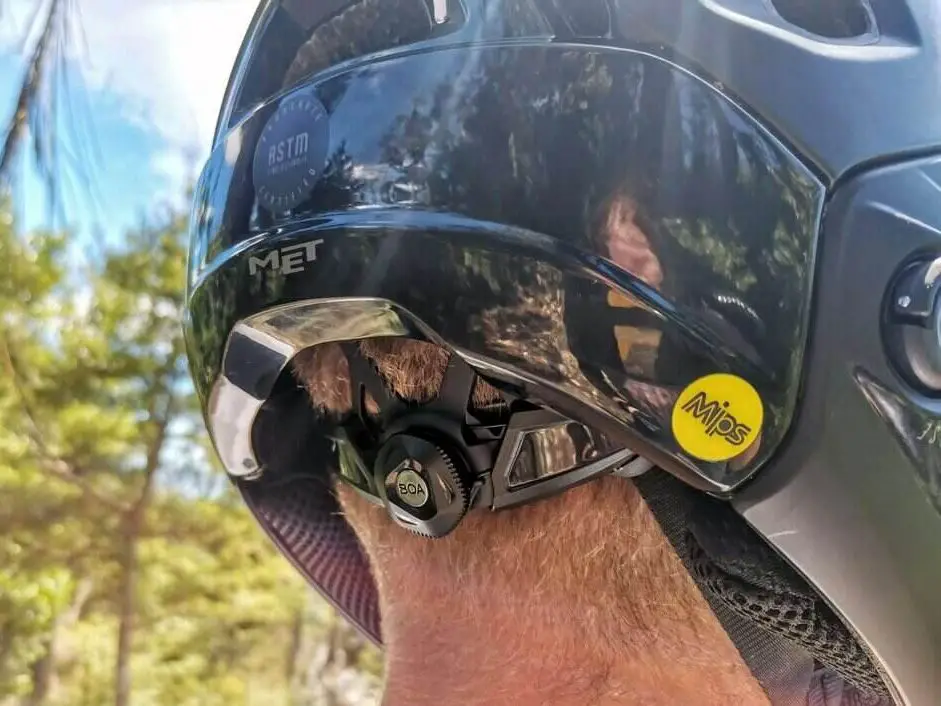
Additional cheek pads come in the box so you can change the thickness of padding in the chin guard.
Weighing in at 840g (with the chin bar) it is a reasonably light full face helmet. It’s a fair bit heavier than the likes of the Bell Super Air R (640 g) but similar to the Bell Super DH (890 g). Unless you have been riding with a super light half shell previously, it is unlikely you will notice the weight of this helmet.
Safety
The Met Parachute MCR is downhill certified (meets ASTM F1952 requirements). This means you can crash assured that the helmet can withstand sufficient force to keep your head and brain intact.
Protection of the brain within the Parachute MCR is covered by MIPS (Multidirectional Impact Protection System) with is a patented technology in a lot of helmets. Essentially, this works by allowing the external shell of the helmet to move independently of the inner MIPS liner (which sits against your head) in an impact. This absorbs some of the energy from the rotation, reducing the amount of force transferred to your skull and brain. Here at MTB GearBox, we see MIPS (or a similar system) as essential, and would pretty much never ride without it.
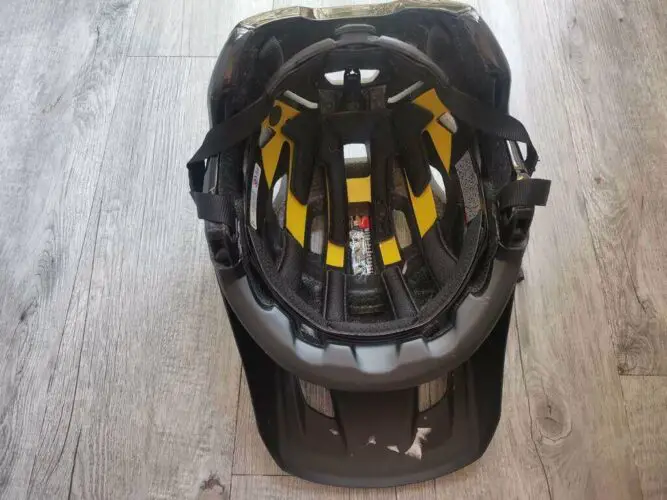
The back of the helmet extends down far enough to keep the rear of the head protected in a crash. Even as a half shell, the helmet has plenty of protection around the back of the head, over the temples and above the ears in case of an awkward crash.
Ventilation
The helmet has 21 vents, with internal air channeling. As a result, the ventilation is pretty darn good.
While I wouldn’t go climbing long hills with the chin bar attached, I don’t find the need to take the chin bar off at every opportunity either. You can feel the wind passing through the lid even at low speeds.
As a half shell, the ventilation is up there with some of the best, such as the Specialized Ambush or the Smith Forefront 2.
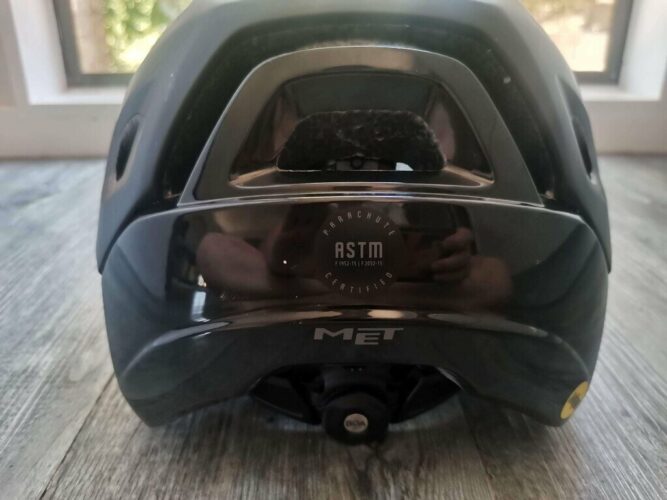
Visor
The visor on the Met Parachute MCR is designed to flex under impact. The idea behind this is to prevent the visor from causing your neck or head to bend at awkward angles in a crash. Having a flexible visor is a different approach – most helmets design visors to break away under impact. However, this seems to be a sensible approach so that you don’t have to refix the visor after a crash!
The adjustable visor has two set positions. One high, and the other extra high! It does seem odd that the visor doesn’t come any lower. I’d personally prefer the visor did go lower, as I tend to ride in the evenings when the sun is lower and hence having a lower visor helps a bit in keeping the sun from the eyes.
The high position allows plenty of room to store goggles or glasses when they aren’t needed too.
Otherwise, the visor is quite long. This does occasionally negate the high visor positioning, but it does look somewhat funny when the helmet is in half-shell.
Durability
The helmet is fully wrapped in a polycarbonate shell which protects the inner foam layer. This prevents deterioration of the foam and improves the longevity of the lid.
The magnetic chin bar release is the only aspect of the helmet I could see breaking. The clips are a little flimsy, and if you use a little too much force when unclipping the chin bar
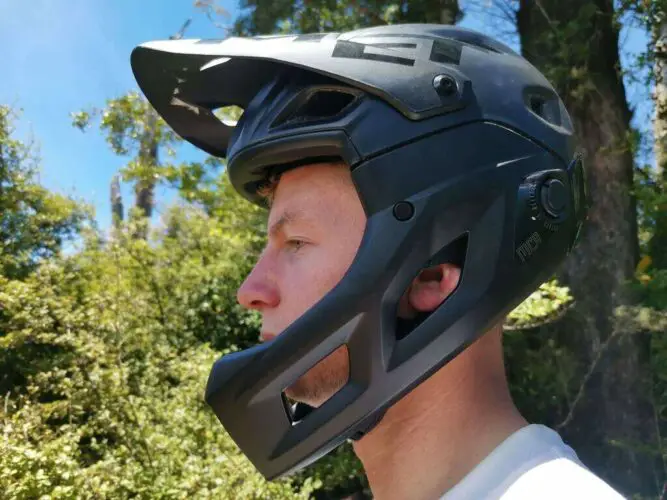
Features
- MCR attachment system
- MIPS anti-rotational system
- BOA retention system
- Adjustable cheek pads
- Flexible and adjustable visor
- Fidlock Magnetic Buckle
- 21 air vents and internal channeling
- 3 sizes (S, M, L)
Comparison and Price
As mentioned earlier, convertible helmets are split into those with the downhill certification and those without. The Parachute MCR is heavier and less ventilated than helmets without this certification, such as the Bell Super Air R or Bell Super 3R.
More comparable to the Parachute MCR are the Bell Super DH, the Giro Switchblade, and the Leatt DBX 4.0 as each of these is downhill certified.
The Giro Switchblade has a slightly unique design – the chin bar detaches in front of the ears, so your ears are covered in half shell mode – is the heaviest of the lot. Fortunately, it is also the cheapest.
The Leatt DBX 4.0 is a new player in the convertible game. We found that the fit and comfort levels did not match the Parachute MCR even close. The DBX 4.0 is a nice looking helmet though, and slightly cheaper than the Parachute MCR.
The real comparison is between the Bell Super DH and the Parachute MCR. Both are similar in price and just as comfortable as one another. Having thoroughly tested these helmets for a while, there is no clear winner. The Met Parachute MCR is lighter, without feeling less sturdy, durable or protective. The Super DH however has MIPS spherical which allows the outer shell to move relative to the inner shell, providing additional safety features, as well as slightly better ventilation. The Met Parachute MCR does look more sleek though!
Final Thoughts
After riding with the Met Parachute MCR, we found that we won’t be riding without it anymore! It has quickly become the go to helmet, ditching my old half shell for the sleek looking Parachute MCR. It is light, comfortable, and it is super easy to bring the chin bar along for the harder tracks.
There are so many advantages to having a convertible helmet- one helmet where ever you go, a more comfortable climb, and you don’t sacrifice on safety! The Met Parachute MCR is one for those wanting a downhill rated helmet, without it being overly bulky. It sits nicely on the head, and, in our opinion, looks pretty good.
For more reviews on convertible helmets, check out the Bell Super Air R or the Best Convertible Helmets on the market here.

